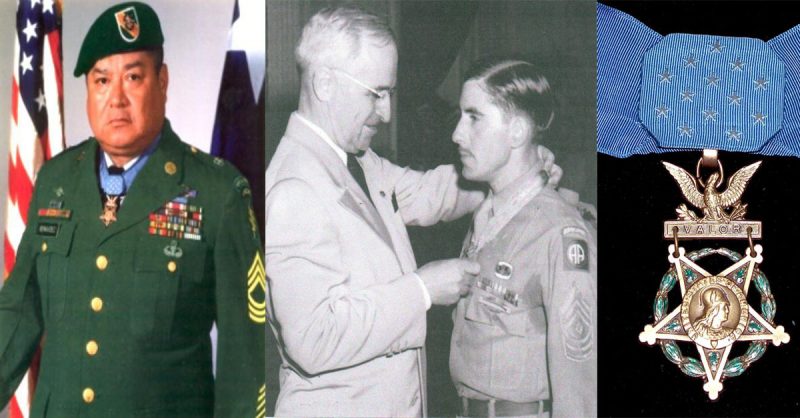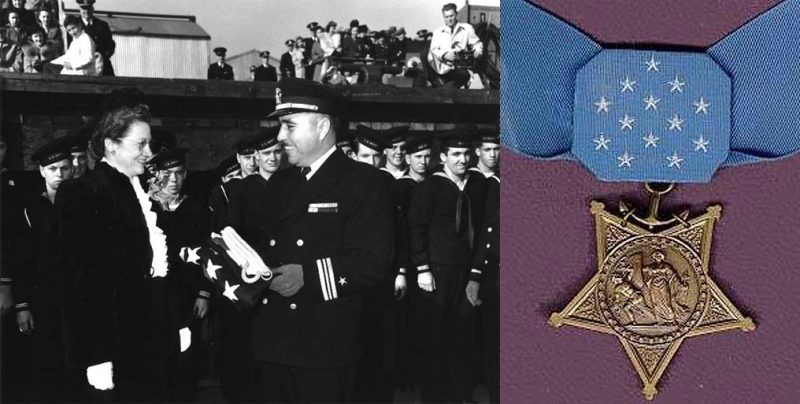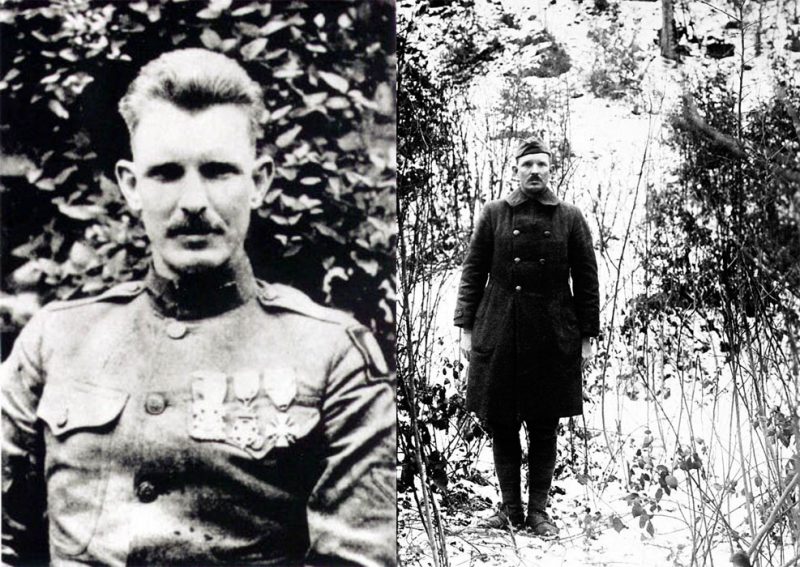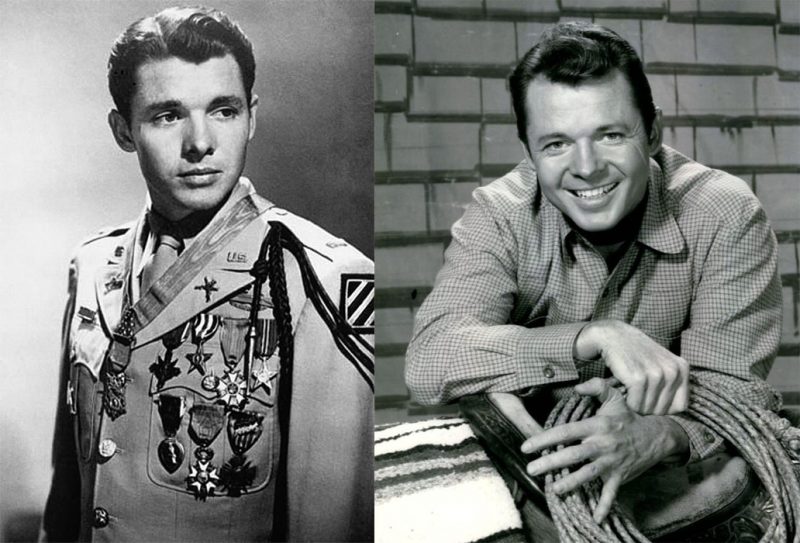Images Used (From left): (1) MSG Roy P. Benavidez awarded Medal of Honor for his outstanding services in Vietnam (2) President Harry S. Truman presents the Medal of Honor to First Sergeant Leonard Alfred Funk Jr., the US paratrooper who took out 40 Nazis in 60 seconds (3) US Army Medal of Honor
The Medal of Honor, the highest military honor awarded by the United States, was created in 1861 during the American Civil War. So far 3,469 Medals of Honor have been awarded since the creation of the decoration and almost half of them were awarded for the actions carried out during the four years of the Civil War. The US soldiers, marines, airmen, sailors and coast guards have been awarded by the US president for personal acts of gallantry above and beyond the call of duty while fighting an enemy of the United States. More than half of the Medals of Honor have been awarded posthumously since 1941 due to the nature of the criteria of the medal. Listverse, the popular web blog, reported on 10 outstanding actions to earn a Medal of Honor.
(10) LCmdr. Ernest E. Evans (August 13, 1908 – October 25, 1944), WWII:
Lieutenant Commander Ernest Edwin Evans was awarded the Medal of Honor posthumously for his stunning heroism while leading the Fletcher class destroyer USS Johnston straight into a Japanese fleet that outnumbered theirs on October 25, 1944 in the Battle of Leyte Gulf off Samar Island in the Philippines Sea.
Evans was born in Pawnee, Oklahoma on August 13, 1908 with a Native American ancestry, half Cherokee and a quarter Creek. He graduated from the US Naval Academy in Maryland in 1931. During the WWII he commanded the Clemson-class destroyer USS Alden. It was named after James Alden, Jr. a Rear Admiral who showed gallantry and assisted in the Union victory during the Civil War. Evans later became the skipper of USS Johnston.
On the fateful day, October 25, 1944, USS Johnston, led by Evans, fought alongside with destroyers USS Hoel and USS Heermann, four destroyer escorts, six escort carriers with just 30 aircraft each against a much superior Japanese fleet consisting of four battleships, eight heavy & light cruisers and a number of destroyers. The US forces formed the task unit 77.4.3, also known as Taffy 3 which was also supported by the aircraft from Taffy 2 or task unit 77.4.2. Even survival of the Allied forces was at stake then as the Japanese fleet was just 15 miles away from them.
Taffy 3 was not prepared for a naval engagement as Fleet Admiral William Frederick Halsey Jr. took the third fleet northwards. So no attack was expected from the north. But Halsey took the third fleet significantly away from Leyte Gulf chasing after another Japanese fleet.
Another Japanese fleet came to destroy the allied navy on Leyte. Taffy 3 wanted to take an evasive action initially. But Evans refused to accept defeat. Evans declared through the intercom that it would be a fight against overwhelming odds from which survival could not be expected. He also added that they would do whatever damage they could. He ordered USS Johnston to attack the enemy fleet at maximum speed alone. Admiral Sprague was in charge of the task unit 77.4.3. Upon watching the charge by USS Johnston, Sprague said that one got to die of something. He also called his fleet small boys and ordered all to attack.
The Japanese fleet fired their 18.1 inch, 16 inch and smaller guns blasting the water on either sides of Johnston. But Evans successfully led the ship within attacking range of his 5 inch guns. But the hulls of Japanese battleships and cruisers could not be penetrated with those guns. He ordered to concentrate firing on the upper decks to ensure maximum damage. This move ensured knocking down the superstructures and setting the ships on fire. Torpedoes fired from Johnston blew off the bow of Kumano, a heavy cruiser. This hit forced another Japanese cruiser to leave the battle to assist in evacuation.
The Japanese were finally able to hit Johnston with a 14 incher and three 6 inchers. Half of the engine power of Johnston and electricity to the aft gun turret was knocked out. One blast ripped off two fingers from the left hand of Evans and burned off his shirt. Despite being crippled, Johnston refused to withdraw and set out a smoke screen to mask other incoming ships from its task unit.
Other destroyers and destroyer escorts arrived at the scene and every man was assigned to suicidal mission in order to allow the escort carriers to escape. Johnston battled it out with gigantic battleships, cruisers and a line of 4 destroyers and drove off the destroyers. But another round of firing knocked out the engine totally and blew up several 5 inch shells in the forward magazine.
Johnston was crippled and dead in the water when Japanese navy surrounded it and fired on it from all sides. Astonishingly, even at such dire situation, Evans did not give orders to abandon ship until all remaining rounds had been fired at the enemy. He even fired the flare like starbusts and sandbag rounds intended for practice. When the Japanese ships had been passing the survivors in the water, Japanese sailors threw food at them in the water and shouted ‘Samurai! Samurai!”, clearly impressed by the gallantry of the crew of USS Johnston. The fate of Evans remains a matter of conjecture among the survivors. He was not among those rescued from the water after the battle.
Images Used (From Left): (1) Lieutenant Commander Ernest Edwin Evans at the commissioning of USS Johnston on October 27, 1943 (2) Navy Medal of Honor
(09) 1SG Leonard A. Funk, Jr. (August 27, 1916 – November 20, 1992), WWII:
Leonard Alfred Funk Jr. was a first Sergeant in the 82nd Airborne Division at Holzheim, Belgium during WWII. On January 29, 1945, a dark but humorous episode of warfare occurred. Funk and his group of paratroopers were on a mission to assault the town. He left 4 soldiers to guard around 80 German prisoners, while he went ahead to scout the town with other units.
But 10 German soldiers were patrolling in the area who overpowered the 4 Americans. The Germans liberated the prisoners and armed them. When Funk returned he encountered a group of over 80 German soldiers. A German officer aimed an MP-40 at his stomach and shouted something at him in German. But Funk calmly looked around to find himself surrounded by around 90 Germans, half of whom were armed. He also saw the 5 disarmed fellowmen. But Funk had weapons and possessed enough nerve. The German soldier shouted at him again and Funk started to laugh. Funk or other Americans didn’t speak German. And he found it funny that the German officer had expected him to understand German.
Laughter is contagious and due to Funk’s laughter and non-compliance, some German soldiers also started laughing. Funk started laughing so hard that he had to bend over. The German officer got angrier and was shouting more and more. Then, in the twinkling of an eye, Funk aimed his Thompson submachine gun at the Germans and emptied the entire 30 rounds of 0.45 ACP cartridges. Before the surviving Germans could react, he replaced the empty clip with a new one and opened fire at them again. He also screamed at his fellow men to pick up weapons. They had obliged and the small American force gunned down 20 Nazis. The rest of the Germans dropped their weapons and surrendered.
After successfully overwhelming the Germans, Funk started laughing again. He termed the lightning fast assault as the ‘stupidest thing ever’. Funk was awarded Medal of Honor on September 5, 1945. He was honorably discharged from the US Army in June, 1945. After the war, he worked for the US Department of Veterans Affairs till 1972. He died at age 76 and was buried in Arlington National Cemetery in Virginia.
Images Used (From Left): (1) President Harry S. Truman presents the Medal of Honor to First Sergeant Leonard Alfred Funk Jr., the US paratrooper who took out 40 Nazis in 60 seconds (2) US Army Medal of Honor
(08) Capt. Robert “Bobbie” E. Brown (September 2, 1907- November 8, 1971), WWII:
Robert Evan Brown Jr was a First Sergeant of Patton’s 2nd Armored Dvision at the beginning of WWII. He was promoted to Second Lieutenant and transferred to 1st Infantry Division after evaluation of his performance while fighting across North Africa. He led a platoon of C Company at Omaha Beach on D-Day, June 6, 1944. While fighting across France, commander of his company was killed and Brown assumed command of that unit. The promotion became official after a few days.
The Allies were on a mission to advance from Paris to the Rhine. In October 1944, the American and Nazi forces were fighting each other around Aachen, now the westernmost city of Germany. Battle of Crucifix Hill that took place on October 8, 1944, was part of Battle of Aachen. The objective of Battle of Crucifix Hill was to gain control of the Cruicifix Hill on which a maze of enemy pillboxes and bunkers had been built. On October 8, 1944, Brown received the orders to attack Crucifix Hill.
The Allies had faced one of the hardest fights in Europe during the Aachen campaign, especially during the battle of Crucifix Hill. Brown’s Company C consisted of around 120 men who were assigned to either take the hill or die trying. The total number of American soldiers on the hill was an entire regiment of around 500. An equal number of well entrenched Germans were deployed to defend the Nazi outposts. Due to having control of the hill, the Germans were able to pour down artillery on the entire town below. So the Allies needed to take control to complete surrounding Aachen.
There were over 43 pillboxes and bunkers with lots of machine guns and men in that hill. Brown and his C Company were assigned pillboxes 17 to 20, 26, 29 and 30. The most dangerous among these was pillbox 20 which had a 360 degree turret on top of the pillbox with an 88mm cannon. The walls were made of 6 feet of concrete reinforced by steel.
Brown had crawled 150 yards under extensive enemy fire to pillbox 18 and blew it up with a satchel charge. He crawled 35 yards more amidst heavy enemy fire to reach number 19. Several mortar rounds landed near him. As a result he was knocked down. But heroes like Brown are tough cookies. He got back up again, climbed on top of pillbox 19 and dropped a Bangalore torpedo through a hole in the roof. This special torpedo was originated in Bangalore, India. It’s an explosive charge placed within one or more connected tubes and effective for clearing obstacles while under fire. The Bangalore torpedo had blown off and made a larger hole. Through this whole he dropped a satchel charge and destroyed the pillbox.
Prime target, pillbox 20 had 45 men with weapons and 6 more machine guns aimed out around it. When Brown returned to cause more damages to the Germans, a sergeant saw bullet holes in Brown’s canteen. Brown had been hit in the hip and was bleeding heavily. However, he crawled down a communication trench 20 yards from pillbox 19 to 20. Then he saw a German entering a steel door. Brown, an ex-boxer, had knocked the enemy down in one punch and threw two satchel charges inside and ran away to safety.
Pillbox 20 exploded so violently that flames from it even caught a tree on fire. Brown led his men for further destructions of enemy posts. After half an hour of fierce fighting, the hill was nothing more than smoking rubble. After the war, Brown was in and out of hospitals, trying to get his 13 war wounds repaired. His 30 years of military service to his country ended with the rank of Captain in 1952. In addition to the Medal of Honor he was also awarded 2 Silver Stars, one Bronze Star and a Purple Heart. Haunted by unhappy war memories and in chronic pain from his war related injuries, Brown committed suicide, by a self-inflicted gunshot to his chest, on November 8, 1971.
Image Used: Captain Robert Evan Brown Jr.
(07) MSG Roy P. Benavidez (August 5, 1935- November 29, 1998), Vietnam:
Raul Perez Benavidez was a member of the 5th Special Forces Group and became an advisor to an infantry regiment of South Vietnamese Army in 1965 during the Vietnam War. He was evacuated to United States after he had stepped on a land mine during a patrol. Doctors declared that he would never walk again. Due to his determination and excruciating practices, he walked out of the hospital in July 1966. Despite chronic pain from his injuries, he returned to South Vietnam in January 1968.
On May 2, 1968, a 12-man Special Forces patrol unit including 9 Degars, indigenous people of Central Vietnam, was surrounded by a North Vietnamese Army (NVA) battalion of about a thousand soldiers. The outnumbered 12 men had been trying to hold them off but were being overpowered. Benavidez heard the appeal for help in the radio and boarded a rescue helicopter with first aid kits. He did not get time to take his weapons. He jumped from the helicopter into the hot landing zone with just a knife and his medical bag.
Benavidez sprinted across 75 meters of open terrain amidst gun fire to reach the pinned down team. In the process, he was shot 4 times, once through his both cheeks knocking out four molar teeth, twice in the right leg and another glancing shot off his head. He refused to stop on the way despite such severe wounds. He had simply ignored those and started administering first aid.
The rescue chopper that carried him left, as it was not designed to extract men. An extraction helicopter was sent and Benavidez directed the men to facilitate the landing of the chopper. With his wounds, he threw smoke canisters to direct the landing of the chopper and carried and dragged half of the wounded soldiers of that team to the chopper. He provided protective fire into the trees as the chopper moved across the landing zone collecting the wounded. The enemy fire increased and Benavidez was hit again, this time solidly in his left shoulder.
He got back up and ran towards the platoon leader, who had been lying dead on the ground, and retrieved important classified documents. He was further shot in the abdomen and grenade explosion nearby peppered his back with deadly shrapnel. The pilot of the chopper was mortally wounded by then and the chopper crashed. Though in critical condition, Benavidez ran to the wreckage and got the wounded soldiers out of the crashed helicopter. He positioned them in a defensive perimeter while waiting for the next chopper. The enemy intensified attack but Benavidez crawled and ran around the perimeter supplying water and ammunition to the wounded men.
The North Vietnamese Army was gaining momentum to wipe them out. But Benavidez requested for tactical air strikes with a walkie talkie and threw smoke to direct the incoming firing of approaching gunships. The extraction chopper landed. But by this time, he was shot again in the left thigh while giving first aid to a wounded soldier. He still carried some of the men to the chopper and directed others. An NVA soldier rushed out from the woods and hit his head with an AK-47 inflicting a skull fracture and a deep cut to his left arm. But superman Benavidez got back up and chopped off the enemy soldier’s head with one swing of his knife. He resumed carrying the wounded to the chopper and was shot twice more in the lower back. He also shot two more NVA soldier who had been trying to board the chopper. He made one last trip around the landing zone for important documents and finally boarded the chopper. He had lost a staggering 2 quarts or 1.89 liter blood. Before he blacked out he shouted to one of the fellowmen “Another great day to be in South Vietnam”. The battle lasted for around six hours and he had been wounded 37 times.
At the base camp, he was examined and thought to be dead. But Benavidez spit on the doctor’s face before the doctor could zipper up the bag. He was evacuated to Brooke Army Medical Center in US again, where he recovered. He retired from US Army in August 1976 as a master sergeant. He had been initially awarded the Distinguished Service Cross for extraordinary heroism which was later upgraded to the Medal of Honor. He was also awarded four Purple Hearts and over a dozen other military decorations and awards. Roy Benavidez died on November 29, 1998, at the age of 63.
Image Used: MSG Roy P. Benavidez (center) flanked by US Secretary of Defense Caspar Weinberger (left) and President Ronald Reagan during Medal of Honor ceremony for Benavidez in 1981
(06) Cpl. Tony Stein (September 30, 1921- March 1, 1945), WWII:
Tony Stein enlisted in the US Marine Corps on September 22, 1942. He was a member of the elite Paramarines, a specialized US Marine Corps unit that used to especially train to drop from aircraft by parachute. Paramarines were disbanded in 1944 and Stein was assigned to several other Marine Corps Units. He fought in the Vella Lavella and Bougainville campaigns in the South Pacific Theater between 1943 and 1945. In the Bougainville campaign, he shot 5 snipers in a single day.
He was promoted to Corporal and drafted into Company A, 1st Battalion, 28th Regiment, 5th Marine Division. On February 19, 1945, he took part in the amphibious landings that started the Battle of Iwo Jima in the middle of the Pacific Ocean. The assault was being carried out across the narrow part of the Island in order to cut off the Mount Suribachi from the rest.
While the unit moved through inland, Stein assaulted a series of enemy pillboxes using his .30 caliber M1919 Browning machine gun nicknamed ‘stinger’. He collected the gun from a wrecked navy fighter aircraft on another island and customized it into a very effective personal machine gun. He always carried it with him.
He stood up from cover to draw enemy fire to him and away from other pinned down marines and ran amidst heavy gun fire all around him. He charged and killed 20 enemy men before running out of ammunition. His stinger fired 100 rounds in just 5 seconds. During assaulting the pillboxes, he made eight trips back to the beach to get ammunition and resume fighting. Each time, he carried a wounded Marine with him on his shoulders. On the first day of action, he demolished at least 14 Japanese installations.
The 28th Marines then helped capture the Mount Suribachi and raised the US flag on its peak on February 23, 1945. Stein was wounded during the operation and evacuated to a hospital ship. Meanwhile, his regiment advanced to the west side of the island to capture the heavily defended Hill 362A. But there they took heavy casualties. Stein had heard of this and left the hospital ship to assist his unit. He was killed by a sniper on March 1, 1945 while leading a 19 man patrol unit to take down a machine gun post which had pinned down Company A. He was initially buried in a military cemetery on Iwo Jima. But his remains were returned back to United States and buried with full military honors in 1948.
Stein’s Medal of Honor was presented to his widow on February 19, 1946. When asked about Tony Stein afterwards, Joe Rosenthal, who took a famous flag raising photo on Suribachi said that running through bullets and not getting hit was like running through rain and not getting wet.
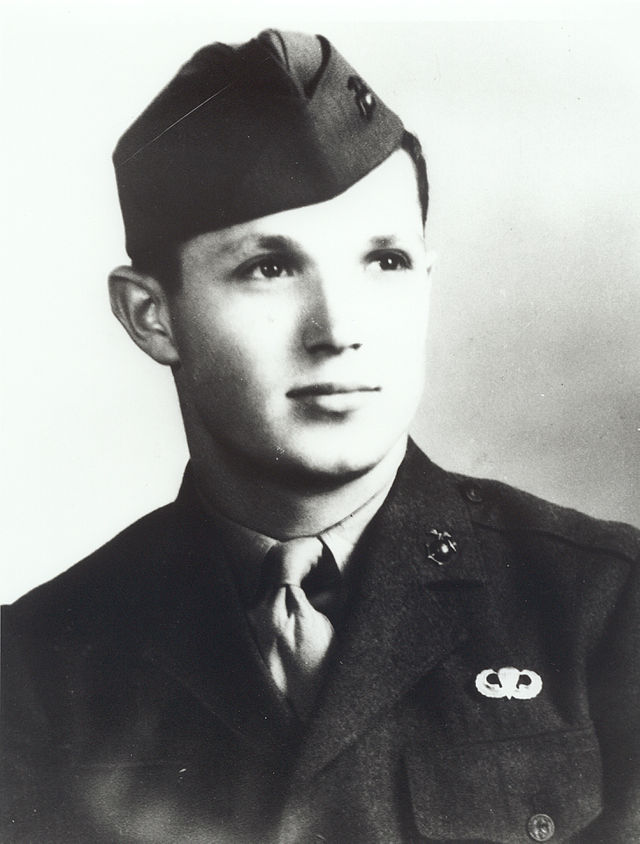
(05) Sgt. Thomas A. Baker (June 25, 1916- July 7, 1944), WWII:
Thomas Alexander Baker was serving as a private in the Company A, 105th Infantry Regiment, 27th Infantry Division on June 19, 1944. Baker and his company were on Saipan in Northern Mariana Islands in the western Pacific Ocean on that day. He ran ahead of his unit with a bazooka and successfully destroyed a Japanese pillbox. The enemies had been firing on his company from this pillbox.
Several days later, Baker single handedly attacked a group of 12 Japanese soldiers and killed them. After that, he ran back and occupied a rearguard position for the safety of his fellow men. As the American soldiers were advancing across open terrain, a group of 6 Japanese soldiers were waiting stealthily to ambush the next group of American soldiers to pass. Baker surprised them. He shot all 6 Japanese soldiers dead.
Three weeks later, the Battle of Saipan was at its final stage. The Japanese forces carried out a banzai attack, a traditional last-ditch attack used to be carried out by the Japanese forces to avoid dishonor or surrender. On July 7, 1944, Baker’s perimeter was attacked from three sides by 3,000 to 5,000 Japanese soldiers. He dug into a foxhole remaining on the line and fired at the Japanese soldiers until running out of ammunition. Sometimes the enemies were as close as 5 yards away from him. He shot down a number of them and he was shot in the abdomen. After running out of ammo, he used his empty rifle as a baseball bat in hand-to-hand combat against a dozen more Japanese.
A fellow comrade piggybacked Baker about 50 yards. The rescuer himself was shot dead by a Japanese soldier. Baker took the rescuer’s rifle and shot the Japanese soldier dead. When another American combatant came to rescue Baker, he refused to be moved away any farther. He preferred to be left behind to die rather than risking lives of any more of his buddies. A third soldier also offered him assistance while withdrawing but he refused and asked for a .45 soldier’s pistol with 8 rounds of ammunition. The soldier propped Baker against a tree and left. When he was last seen alive, he had a pistol in his hand and was calmly facing the enemies. Later Baker’s body was found in the same position, lying dead against a tree with an empty gun and 8 dead Japanese soldiers around him. He was posthumously promoted to sergeant and awarded the Medal of Honor on May 9, 1945.

(04) Col. Robert L. Howard (July 11, 1939- December 23, 2009), Vietnam:
Robert Lewis Howard was a Sergeant First Class when he risked his life during a rescue mission in Cambodia on December 30, 1968 while participating in the Vietnam War. He was nominated for the Medal of Honor for three separate actions. He was a staff sergeant of the highly classified US special operations unit called ‘Military Assistance Command, Vietnam – Studies and Observations Group’ (MACV-SOG). Men from this unit conducted strategic covert operations all over Vietnam and into Laos and Cambodia. At that time these actions were quite sensitive to world opinion of the United States.
That is why Howard’s first two actions were downgraded to a Silver Star and the Distinguished Service Cross. The US government did not want to draw much attention to the special unit. Finally, he was awarded Medal of Honor for his rescue mission in Cambodia to find Private First Class Robert Scherdin. After Howard’s American-Vietnamese platoon had left the cover of its chopper, it was attacked by 2 companies of North Vietnamese Army, around 300 men.
During initial engagement, Howard took shrapnel to his legs and forearms from a grenade explosion. His rifle got destroyed in the explosion too. When he sat back up, he saw that his platoon leader had been critically wounded and exposed to fire. Unable to walk, he crawled through a hail of machine gun and small arms fire to retrieve his wounded leader. While administering first aid and removing the equipment of the officers, an enemy bullet struck one of the ammunition bags on his belt, detonating several magazines of ammos.
He sought cover, but only momentarily. He began dragging the critically wounded soldiers toward the platoon area. With utter disregard for his safety, he organized the platoon into a good defense force and also administered first aid to the wounded. He further encouraged the defenders by well directing their fire on the encircling enemy. Howard’s men and supporting aircraft fought the NVA for over 3 and half hours until the arrival of two more rescue helicopters. Howard refused to leave ground until everyone else was aboard, all the while taking extensive enemy fire from the jungle around the landing zone.
He was wounded 14 times in a 54 month period during Vietnam War performing great deeds like this. Beside the Medal of Honor, he was also awarded 8 Purple Hearts, 2 Distinguished Service Crosses, 1 Silver Star, 4 Bronze Stars and several other military awards and decorations. He retired in 1992 as a Colonel. He died of pancreatic cancer on December 23, 2009.
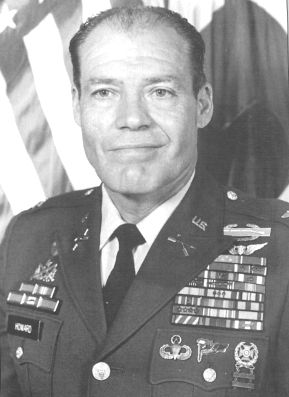
(03) SGT Alvin C. York (December 13, 1887- September 2, 1964), WWI:
Alvin Cullum York was recently promoted to Corporal when he helped capture his battalion the German positions near Hill 223 along the Decauville rail-line north of Chatel-Chehery in northern France on October 8, 1918. This earned him the Medal of Honor.
York had a history of drinking and fighting during his youth. Despite that, he attended church regularly. In his later life, he revealed that at the outbreak of WWI his reaction was that he had been worried, he hadn’t want to go and kill and that he had belief in his Bible. York registered to be drafted into the military on June 5, 1917, at the age of 29 as according to Selective Service Act 1917, it was compulsory for all men between age 21 and 31 to get drafted into the armed forces.
He served in the Company G, 328th Infantry Regiment, 82nd Infantry Division stationed at Georgia then. In the beginning he was quite troubled by the war and had several conversations with his commanders. In those lengthy conversations he cited from the Biblical passages about violence. Seeing his anti-war mental conditions, he was granted a 10 day leave to visit his home. When he returned, he was convinced that God wanted him to fight and would protect him. He realized the fact that would be helping prevent the Germans from carrying out massacre and save American lives. At Camp Gordon, Georgia, he was well known as one of the finest marksmen.
On October 8, 1918, York’s battalion was on the eventful mission just north of Chatel-Chehery in northern France, just south of Belgium. 17 men, four non-coms and 13 privates were ordered to attack the German line and destroy their machine guns from rear. About 70 Germans were captured by them and they were being disarmed. But the Machine guns spotted the Americans and turned around to fire on them. 9 American soldiers around York got hit, 6 of them dead on the spot.
York was in charge now. He left 7 US soldiers to guard the Germans, while he ran cover to cover. He moved up the hill, shooting all the way. The German machine guns were spitting fire and cutting down the undergrowth all around him awfully. He said that he hadn’t had time to dodge behind a tree or dive into a brush. There had been over thirty of them firing continuous on him. York ran towards the Germans as fast as he could while sharp shooting. He kept yelling at them to come down. He gave them the best that he could.
Astonishingly, he shot 15 Germans dead with his M1917 Enfield rifle and then ran out of ammunition. He then pulled his .45 Colt automatic pistol and shot 6 German soldiers that charged him with bayonets before they could reach him. He grabbed one of the German rifles and fired on few more machine gun nests until the Germans surrendered. He killed at least 28 Germans in this outstanding assault. His heroic feat ensured the Allies take down the German machine gun nest along with 132 German prisoners and several guns. York fearlessly led just 7 men to prevail in such do or die scenario. He was awarded a medal of honor on February 7, 1919 for his heroic actions. He died on September 2, 1964 of a cerebral hemorrhage.
Images Used (from left): (1) SGT Alvin C. York (2) York at the hill where his actions earned him the Medal of Honor; Photographed after the end of World War I, on February 7, 1919
(02) Lt. Audie L. Murphy (June 20, 1925- May 28, 1971), WWII:
Audie Leon Murphy was accepted by U.S. Army on June 30, 1942. He was assigned to Company B, 1st Battalion, 15th Infantry Regiment, 3rd Infantry Division and shipped to Casablanca in French Morocco. On 15th July 1943, he was promoted to corporal. Murphy was a division runner, when 3rd Infantry landed at Licata, Sicily on July 10, 1943. He killed two fleeing Italian soldiers in a scouting patrol near Canicatti in Sicily. He also took part in the September 1943 mainland Salerno landing at Battipaglia, Italy. He and two other American soldiers were ambushed there and one of Murphy’s mates got killed. Murphy and the other American soldier responded by killing five Nazi soldiers with grenades and machine gun fire.
He and his company repelled another German attack by seven soldiers near the Volturno Line, a German Defense line in Italy. They killed 3 German soldiers and took the other four prisoners. Murphy was promoted to staff sergeant in January 1944. He got a Bronze Star for his contributions during the Battle of Cisterna in Italy in January 1944.
He was awarded the Distinguished Service Cross for action taken on August 15, 1944, during the first wave of Allied invasion of Southern France. On that day in Normandy, a German soldier called down from a hilltop saying that he was surrendering. One of Murphy’s buddies took the bait and stood up. But it was a German trap and a sniper shot him. Murphy was infuriated. He jumped up and shot the sniper dead. He then charged up the hill amidst heavy fire and wiped out the machine gun nest of 6 Germans with grenades and gun shots. Then he picked up the German MG-42 machine gun and killed 10 more Nazis around the hillside.
His actions on January 26, 1945 in Holtzwihr, France earned him the Medal of Honor. On that day, his unit had only 19 fighting men left out of 128. A German assault began and he ordered his 19 men to retreat. He, however, stayed on the spot and kept shooting at the approaching Germans until running out of ammunition. Then he climbed onto a burning tank destroyer and used its .50 caliber machine gun to hold the Germans back. The German mortars and panzers kept blowing up the ground around him, but he continued the one man assault for an hour. Then he called in for artillery strikes over the phone of the tank destroyer.
He called the strikes closer to his position blowing up German units and tanks within 50 yards away from him. Finally Murphy called a strike on his position. The Germans were quite close to his position by then. He then jumped from the vehicle and ran towards the woods. The Germans overran Murphy’s position and were struck by the American cannon fire that put them in disarray. Murphy then called in his men and organized an efficient counter strike to drive the German’s back. It is estimated that Murphy’s action that day caused death for 50 Nazis. He was awarded the Medal of Honor on June 2, 1945. Murphy died in a passenger plane crash on May 28, 1971.
Images Used (from left): (1) Lt. Audie L. Murphy (2) Murphy in 1961
(01) Lt. William D. Hawkins (April 18, 1914- November 21, 1943), WWII:
William Deane Hawkins was a 1st lieutenant when he carried out one of the most furious one-man army assault in the history of modern warfare on November 21, 1943 in the attack on Betio Island during the Battle of Tarawa in the Pacific Theater. Hawkins was so confident that he told Robert Sherrod, who later became an editor of Saturday Evening Post that he dared to put his platoon of 40 soldiers against a company of 150 soldiers on Earth and still guarantee a win.
During the first wave of attack Hawkins got slightly wounded by shrapnel. He led his platoon into the coconut palm forest. Within a day and a half, he destroyed six Japanese machine gun nests. He would sometimes stand on top of a track firing point blank at four or five enemy soldiers who fired back at him from hideouts and blockhouses. He was wounded a second time but still refused to give up.
Japanese machine gun nests were pyramid shaped huts about the size of a large trash can made of 6 inch thick steel. A Japanese soldier could pop up from underground into the nest. Such nests were everywhere on the island. Hawkins stood up around 5 yards from these pillboxes and fired his M-1 Carbine at the enemies. Killing the enemy soldiers, he allowed his men to move forward. When he ran out of ammo, he ran up to the enemy and threw grenades or satchel charges.
He destroyed one blockhouse and seven pillboxes single handedly. His wounds included one in the chest. When he was brought back and taken care of by a medic, Hawkins told him to tie bandages loose enough so that he could shoot. The medic radioed Colonel David Shoup, another hero who was awarded Medal of Honor for his leadership on that island. Shoup asked Hawkins to leave but he refused.
Hawkins destroyed three more pillboxes by the end of the day. The fourth pillbox shot him dead while the hero was throwing the last grenade of his life. He was 29 and posthumously awarded the Medal of Honor.
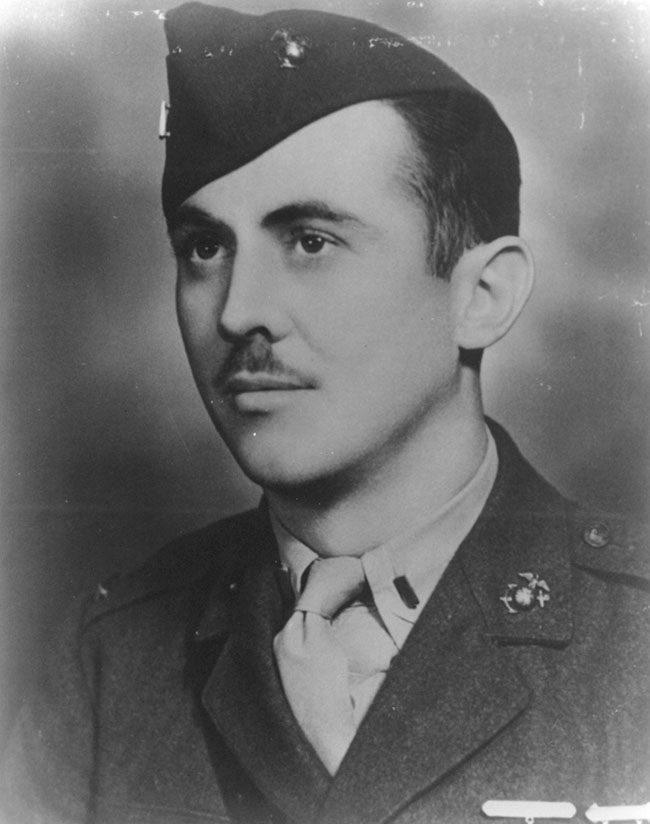
https://youtube.com/watch?v=wW1FL63iAV0
Video Used: Documentary on Medal of Honor
